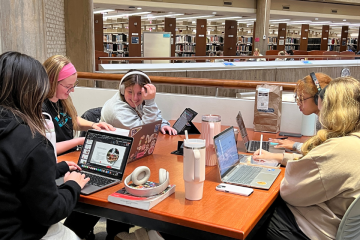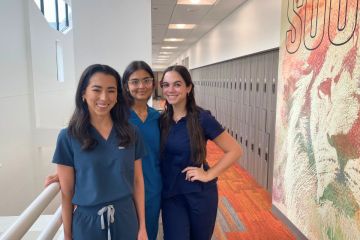Telehealth Programming Connects Nursing Students to Evolving Industry

Virtual patient care has been a common practice by health care providers across specialties for decades. The ability to connect with patients from the comfort and safety of home broadens access and flexibility for both patients and providers.
Though the concept isn’t new, telehealth and telemedicine services grew during COVID-19 when virtual care shifted to a necessity rather than a convenient alternative.
In response to this latest industry shift, graduate nursing students at the university’s Harrisburg campus are learning how to provide virtual patient care through newly incorporated telehealth programming this semester.
“To translate an in-person visit to a remote visit is not always as easy as you’d think,” said Kathleen Sheikh, assistant professor and assistant dean of nursing at the university’s Harrisburg campus.
The programming involves real-world practice conducting a simulated live telehealth encounter. Each simulation is observed by faculty to provide students practice with the method of care delivery as well as offer immediate feedback. Working within a simulated environment affords students experiences to advance telehealth competencies.
“Even though people are used to screen time, conducting an actual visit via Zoom, or similar platforms, is very different, added Sheikh.
Amelia Swartzbaugh, an eight-year nursing veteran with experience in telehealth, couldn’t agree more. A former Post-anesthesia care unit (PACU) and intensive care unit (ICU) nurse, Swartzbaugh currently works as a pre-admissions patient nurse at OSS Health, an orthopedic surgical group in central Pennsylvania.
While the role gave Swartzbaugh some insight into remote patient care, it doesn’t compare to the nuances of telehealth.
“It’s a totally different realm,” said Swartzbaugh.
The remote care lessons have been incorporated into an advanced health assessment course thanks to the support of Tom Bown, ‘67, a 20-year member of the Board of Trustees who now serves as an honorary member, and his wife Bonnie.
Alternating between the patient and nurse role, students work in pairs to conduct a simulated telehealth visit to gain experience guiding patients through an assessment to practice the skills and techniques that are specific to virtual appointments.
Getting comfortable with having that screen in front of you and trying to figure out how to conduct your assessments and conduct those conversations through a computer screen or a telephone is definitely a new experience but it’s one that I’m glad that we got to do in school. —Amelia Swartzbaugh, graduate nursing student
During an in-person visit, nurses may run tests or exercises on patients to determine a diagnosis. Lack of physical, hands-on interactions in a virtual setting means that nurses must rely on other tools to conduct an evaluation.
According to Taylor Hodges, who partners with Swartzbaugh for the exercises, patient interaction and cooperation is key to a successful remote visit.
You have to have patients incorporated into the visit and learn to do some of the assessment for you because you can’t assess them by yourself. You have to have them do things with you, and understanding how to talk someone through that can be difficult. —Taylor Hodges, graduate nursing student
“It definitely gives you a whole new perspective when you have to instruct patients through a screen,” added Swartzbaugh.
Sheikh adds that this virtual experience will give students like Swartzbaugh and Hodges an advantage when they return to full-time practice.
“[Telehealth] is not going to go away and the idea that even if it’s not used as much in the future, it will be an expectation of practice,” said Sheikh.




